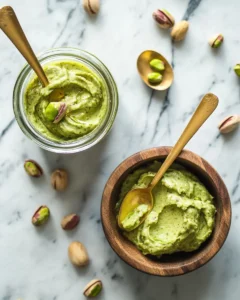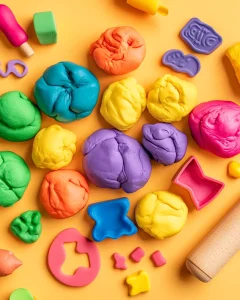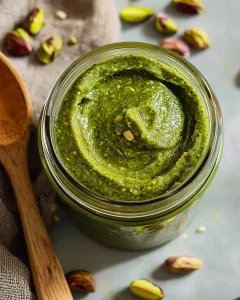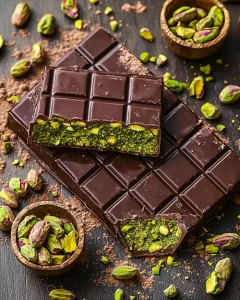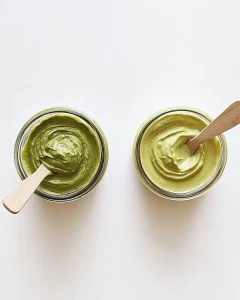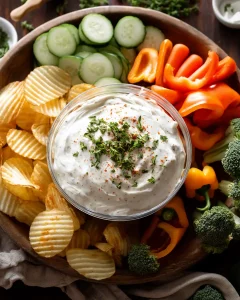Pistachio Butter: Ultimate Homemade Recipe
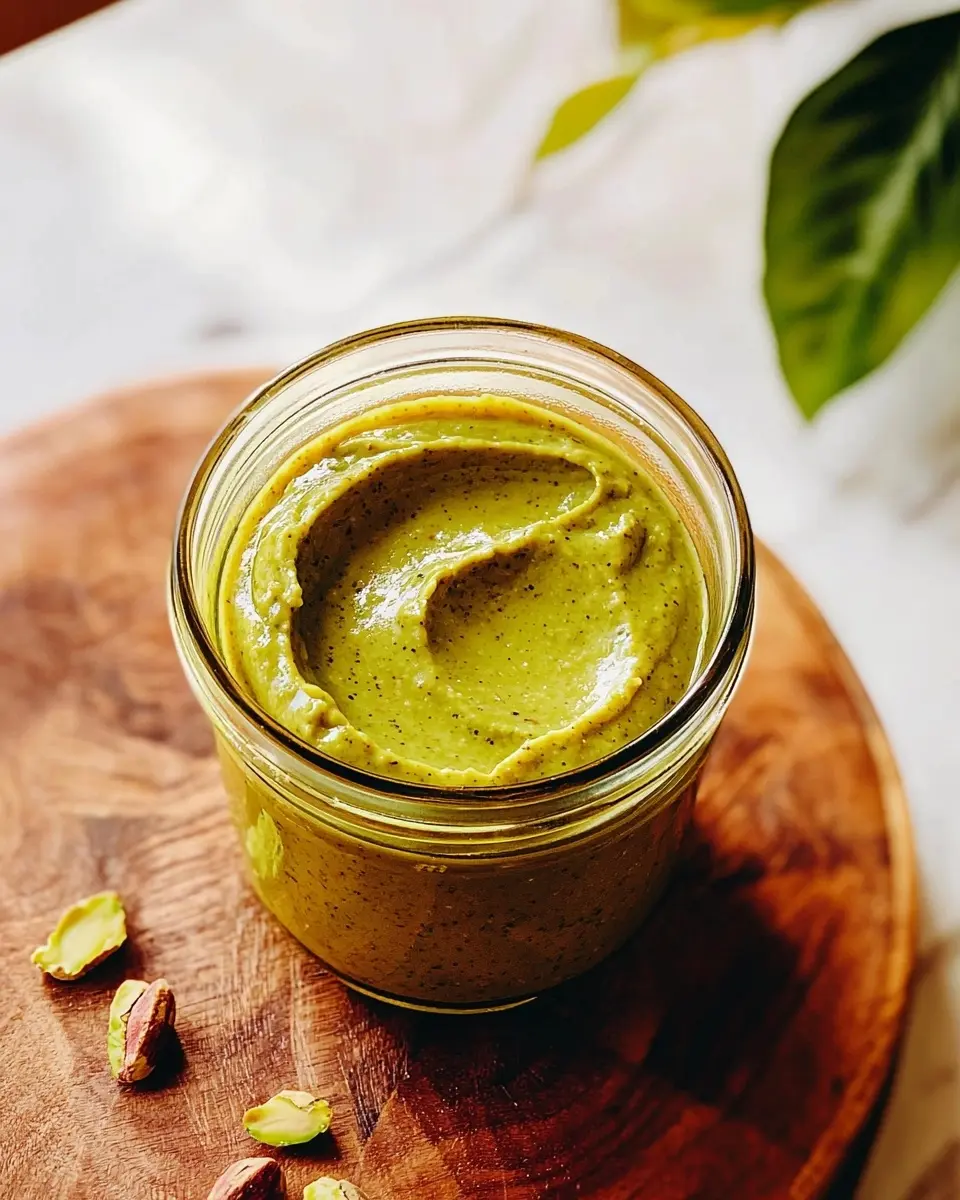
Pistachio butter made easy! Learn how to make homemade pistachio butter with simple ingredients and expert tips for creamy, delicious results.
Table of Contents
Jump To:
The Story Behind My First Batch
Let me tell you about the day I discovered pistachio butter could change everything. Picture this: I’m standing in my kitchen, staring at a bag of pistachios I’d impulse-bought at Costco. My grandmother always said, “Waste not, want not,” and honestly, I had no clue what to do with three pounds of these little green gems.
That’s when inspiration struck. Why not make my own nut butter? After all, I’d been perfecting homemade spreads for over eight years in my kitchen laboratory. Little did I know, this experiment would become one of my most requested recipes at Dessert Haven.
The result? Pure magic in a jar. However, let me save you from my first mistake—I nearly burned that initial batch because I got distracted by a phone call. Oops! Learn from my mishap, and you’ll have silky smooth pistachio butter that puts store-bought versions to shame.
Making homemade pistachio butter isn’t just about saving money. Sure, it’s more affordable than the $15 jars at specialty stores. More importantly, you control every ingredient. No preservatives, no mystery oils, just pure pistachio goodness.
What Makes This Pistachio Butter Recipe Special
This isn’t your average nut butter recipe. After testing dozens of variations, I’ve cracked the code for achieving that perfect creamy texture every single time. The secret lies in proper toasting and patience during the blending process.
Unlike commercial versions loaded with additives, our homemade pistachio butter contains only two ingredients. Furthermore, you’ll discover techniques I learned from studying the methods of renowned chef Thomas Keller, who emphasizes the importance of proper ingredient preparation.
Essential Ingredients for Pistachio Butter
| Ingredient | US Measurement | Metric | Notes |
|---|---|---|---|
| Raw shelled pistachios | 2-3½ cups | 9-16 oz | Look for bright green color |
| Salt | Pinch or more | To taste | Sea salt works best |
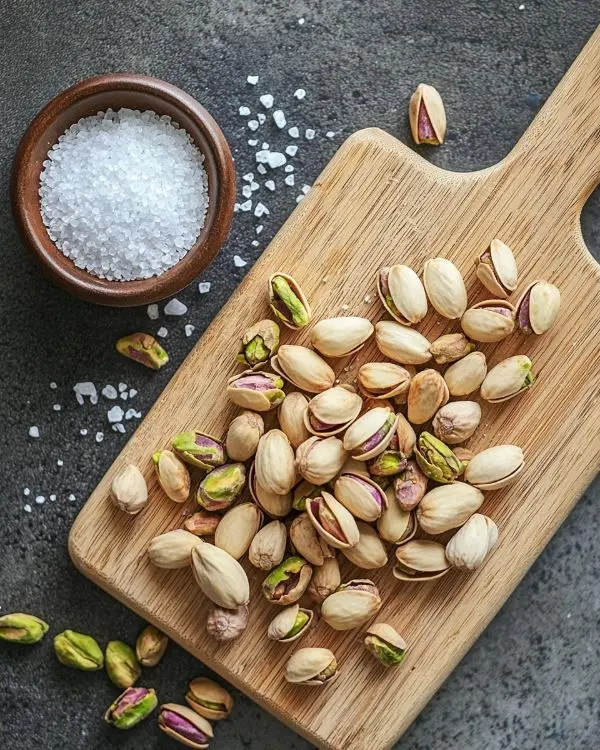
Shopping Tips for Pistachio Butter
Finding quality pistachios makes all the difference. Head to the bulk bins at Whole Foods or Trader Joe’s for the freshest options. Costco offers excellent value for larger quantities. Always choose raw, unsalted pistachios with vibrant green color.
Avoid pistachios that look yellowish or have dark spots. These indicate age or improper storage. Fresh pistachios should smell nutty and sweet, never rancid or stale.
Bold Add-ins and Creative Variations
While traditional pistachio butter shines on its own, consider these exciting additions:
Sweet Variations:
- Honey pistachio butter (add 1-2 tablespoons)
- Vanilla extract (½ teaspoon)
- Cinnamon spice blend
Savory Options:
- Rosemary and garlic
- Za’atar seasoning
- Smoked paprika
International Substitutions
For readers outside the US, substitute measurements as follows:
- 1 cup pistachios = 140g
- Pinch of salt = ¼ teaspoon or 1g
Equipment and Preparation Steps
Essential Equipment
You’ll need a high-powered food processor for this pistachio butter recipe. I recommend at least 7-cup capacity. Cuisinart and KitchenAid models work beautifully. Don’t have a food processor? A high-speed blender like Vitamix can work, though you’ll need to stop more frequently.
Additionally, gather these tools:
- Rimmed baking sheet
- Measuring cups
- Rubber spatula
- Mason jar for storage
Step-by-Step Instructions
Step 1: Toast the Pistachios Perfectly
Preheat your oven to 350°F. Spread pistachios across a rimmed baking sheet in a single layer. Toast for 7-9 minutes, stirring halfway through. You’ll know they’re ready when they smell incredibly fragrant and slightly darken.
Pro tip: Set a timer! I learned this lesson the hard way when I burned my first batch while answering the door. The smell of toasted nuts should be warm and inviting, never acrid or bitter.
Step 2: Cool Down and Set Up
Let the pistachios cool for about 10 minutes. They should be warm but not hot when you start processing. Meanwhile, this gives you time to set up your food processor and clear counter space.
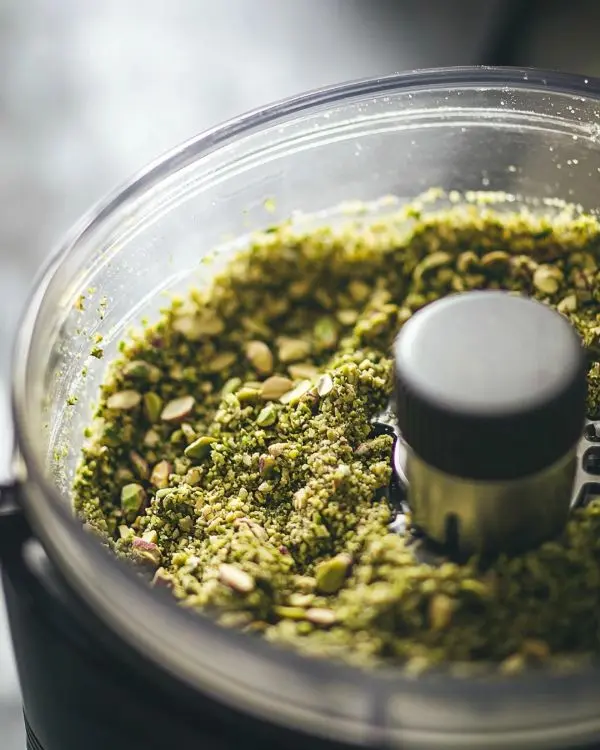
Step 3: Begin the Transformation
Transfer cooled pistachios to your food processor. Add a pinch of salt. Secure the lid tightly and prepare for a journey that takes patience.
Step 4: Blend with Patience and Precision
Start processing and watch the magic happen. First, the pistachios will become flour-like. Then, they’ll form clumps and eventually a ball against the processor sides. Don’t panic—this is normal!
Continue processing, stopping to scrape down sides every minute or so. The mixture will suddenly transform into creamy, glossy butter. This process typically takes 8-12 minutes total.
Temperature control matters here. If your food processor feels warm, stop and let it rest for 5 minutes. As culinary legend Julia Child always emphasized, rushing leads to disappointment.
Step 5: Final Seasoning and Storage
Taste your pistachio butter and adjust salt as needed. Remember, a little goes a long way. Transfer to a clean mason jar and let cool completely before refrigerating.
Expert Tips and Variations
Storage and Make-Ahead Advice
| Storage Method | Duration | Temperature | Notes |
| Room temperature | 1 week | Cool, dry place | Best for immediate use |
| Refrigerated | 1 month | 35-40°F | May thicken slightly |
| Frozen | 3 months | 0°F | Thaw at room temp |
Regional and Seasonal Variations
- California Style: Add a touch of sea salt and lavender for a West Coast twist.
- Southern Comfort: Incorporate a hint of bourbon extract and brown sugar.
- Holiday Special: Mix in warming spices like cardamom and orange zest for Thanksgiving treats.
Common Mistakes to Avoid
Don’t rush the process. I’ve seen countless home cooks give up too early, thinking their food processor isn’t powerful enough. Trust the process—persistence pays off.
Never add oil to speed things up. The pistachios contain enough natural oils to create perfect butter. Adding extra oil results in separation and greasiness.
Nutritional Benefits of Pistachio Butter
Pistachio butter delivers exceptional nutritional value that outperforms many other nut butters. Each serving provides heart-healthy monounsaturated fats, complete protein, and essential vitamins your body craves.
Heart Health Powerhouse
Pistachios contain more antioxidants than most nuts, particularly lutein and zeaxanthin. These compounds support cardiovascular health by reducing inflammation and protecting against oxidative stress. Studies show regular pistachio consumption may lower cholesterol levels and reduce heart disease risk.
The monounsaturated fats in pistachios help maintain healthy blood pressure levels. Furthermore, the potassium content supports proper heart rhythm and blood vessel function.
Protein and Amino Acid Profile
Two tablespoons of pistachio butter provide approximately 6 grams of complete protein. Unlike some plant proteins, pistachios contain all essential amino acids your body needs for muscle repair and growth.
This makes pistachio butter an excellent post-workout snack. The protein helps rebuild muscle tissue while the healthy fats provide sustained energy.
Weight Management Benefits
Despite being calorie-dense, pistachio butter supports healthy weight management. The combination of protein, fiber, and healthy fats promotes satiety, helping you feel full longer between meals.
Research indicates that the act of shelling pistachios naturally slows consumption, but even with ready-to-eat pistachio butter, the nutrient density helps prevent overeating.
Vitamin and Mineral Content
Pistachio butter excels in vitamin B6 content, providing nearly 20% of your daily needs per serving. This vitamin supports brain function, immune system health, and protein metabolism.
Additionally, pistachios offer significant amounts of:
- Copper for energy production
- Manganese for bone health
- Phosphorus for strong teeth and bones
- Magnesium for muscle and nerve function
History and Cultural Background
The story of pistachios spans thousands of years, connecting ancient civilizations to modern American kitchens. Understanding this rich heritage adds depth to every spoonful of homemade pistachio butter.
Ancient Origins
Pistachios originated in Central Asia and the Middle East over 9,000 years ago. Archaeological evidence shows these nuts sustained travelers along the Silk Road trade routes. Ancient Persians considered pistachios a symbol of wealth and status.
The Queen of Sheba reportedly claimed all pistachios in her land for royal consumption. This exclusivity elevated pistachios to legendary status throughout the ancient world.
Mediterranean Expansion
Romans introduced pistachios to Mediterranean regions around the first century AD. The nuts thrived in Italy, Greece, and Spain’s warm climates. Traditional Italian gelato makers began incorporating pistachios into their frozen creations centuries ago.
Sicily became particularly famous for its pistachios, especially those grown near Mount Etna. The volcanic soil imparts unique flavor characteristics that Sicilian pastry chefs treasure to this day.
American Introduction
Pistachios arrived in America during the 1850s through Middle Eastern immigrants. However, commercial cultivation didn’t begin until the 1970s in California’s Central Valley. Today, California produces 99% of American pistachios.
The transformation from exotic import to mainstream American snack happened remarkably quickly. By the 1980s, pistachios became synonymous with premium quality and gourmet cooking.
Cultural Significance
In Middle Eastern cultures, pistachios symbolize happiness and good fortune. Wedding celebrations traditionally include pistachio-based sweets and desserts. The green color represents new life and prosperity.
Persian cuisine features pistachios in both sweet and savory dishes. From rice pilafs to rosewater cookies, these nuts provide distinctive flavor and visual appeal. Iranian families often serve pistachios to honored guests as a sign of respect.
Modern Nut Butter Evolution
The concept of nut butters began with peanut butter in the late 1800s. However, artisanal nut butter popularity exploded in the 2000s as consumers sought healthier, more diverse options.
Pistachio butter emerged as a gourmet alternative, initially appearing in high-end specialty stores. Home cooks eventually discovered they could create superior versions in their own kitchens, leading to today’s DIY movement.
Pistachio Butter Troubleshooting Guide
Even experienced cooks encounter challenges when making pistachio butter. These solutions address the most common problems and help ensure success every time.
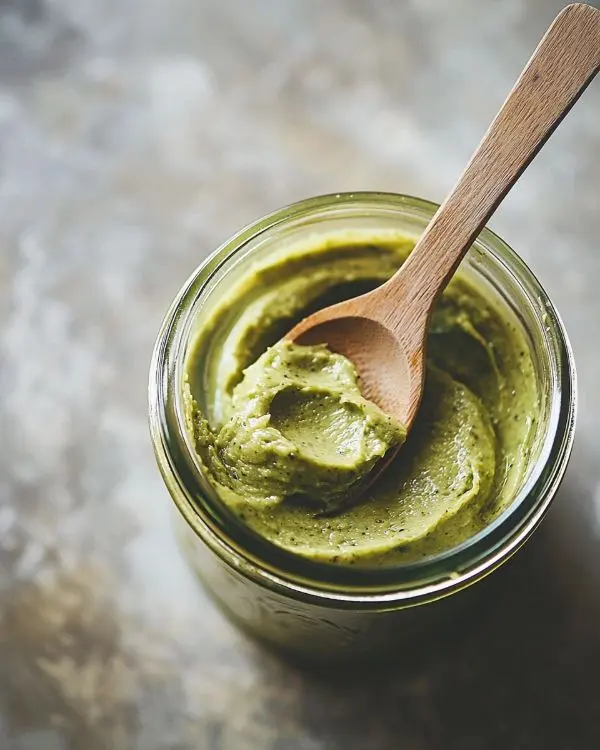
Problem: Mixture Won’t Get Creamy
Symptoms: Pistachios remain chunky or grainy after 10+ minutes of processing.
Solutions:
- Check if pistachios were properly toasted. Under-toasted nuts retain too much moisture.
- Ensure your food processor has adequate power (minimum 400 watts recommended).
- Stop processing if mixture becomes hot; let cool for 10 minutes before continuing.
- Add one additional toasted pistachio at a time to help break the “stuck” pattern.
Prevention: Toast pistachios until fragrant and slightly darker. Cool completely before processing.
Problem: Grainy or Gritty Texture
Symptoms: Final product feels sandy or contains small chunks.
Solutions:
- Process longer—some batches need 15-20 minutes total processing time.
- Scrape down sides more frequently to ensure even processing.
- Check for any unshelled pieces that may have been missed.
- Strain mixture through fine-mesh sieve to remove any stubborn chunks.
Expert Tip: Julia Child always said patience creates perfection. Don’t rush this step.
Problem: Oil Separation
Symptoms: Clear oil pools on top of thick paste underneath.
Solutions:
- This often happens with over-processing. Stir vigorously with a spoon first.
- If stirring doesn’t help, process for 30-second intervals until mixture re-emulsifies.
- Refrigerate for 2 hours, then stir again—cold temperature helps binding.
- Never add extra oil, which worsens separation.
Prevention: Stop processing once mixture reaches smooth, glossy consistency.
Problem: Food Processor Overheating
Symptoms: Machine feels hot, makes unusual noises, or automatically shuts off.
Solutions:
- Immediately stop processing and unplug machine.
- Let cool for 20-30 minutes before attempting to continue.
- Process in shorter intervals (30-60 seconds) with rest periods.
- Consider processing smaller batches if problem persists.
Safety Note: Never force an overheated machine to continue operating.
Problem: Bitter or Off Flavors
Symptoms: Finished butter tastes bitter, rancid, or unpleasant.
Solutions:
- Check pistachio freshness—rancid nuts create bitter butter.
- Ensure pistachios weren’t over-toasted (should be fragrant, not dark brown).
- Taste pistachios before processing to verify quality.
- Start fresh with new pistachios if bitterness persists.
Quality Check: Fresh pistachios should smell sweet and nutty, never musty or sharp.
The Science Behind Perfect Pistachio Butter
Understanding the food science principles behind nut butter creation helps explain why certain techniques work better than others. This knowledge transforms cooking from guesswork into precision.
Oil Extraction Process
Nuts naturally contain 45-60% oil by weight. During processing, mechanical pressure and friction break cell walls, releasing these oils. The released oil acts as a natural emulsifier, binding ground particles into smooth paste.
Temperature plays a crucial role in this process. Gentle warming (from friction) helps oil flow more freely. However, excessive heat degrades delicate flavors and can cause separation.
Maillard Reaction During Toasting
Toasting pistachios initiates the Maillard reaction—the same chemical process that browns bread and creates coffee’s complex flavors. This reaction develops over 600 different flavor compounds, transforming simple nuts into aromatic ingredients.
The optimal temperature range (325-350°F) allows steady flavor development without burning. Higher temperatures create bitter compounds, while lower temperatures produce insufficient flavor development.
Emulsification Science
Pistachio butter represents a natural emulsion—tiny oil droplets suspended in ground nut particles. Lecithin, naturally present in nuts, acts as an emulsifying agent that prevents separation.
Proper processing creates uniform particle size, ensuring stable emulsion. Inconsistent grinding produces varying particle sizes that don’t bind well, leading to separation or graininess.
Oxidation and Freshness Factors
Nuts contain delicate polyunsaturated fats that oxidize when exposed to air, light, or heat. This oxidation creates rancid flavors and reduces nutritional value. Proper storage minimizes oxidation through several mechanisms:
- Airtight containers limit oxygen exposure
- Cool temperatures slow chemical reactions
- Dark storage prevents light-induced oxidation
- Minimal air space reduces oxidation surface area
Texture Development Physics
The transformation from chunky nuts to smooth butter follows predictable physics principles. Initial processing creates angular particles that resist flow. Continued processing rounds these particles while releasing more oil.
The “magic moment” occurs when released oil reaches critical mass—suddenly, angular particles become spherical, and the mixture transforms into flowing butter. This explains why the process seems to “suddenly” work after minutes of apparent failure.
Related Pistachio Recipes
Maximize your pistachio investment by creating complementary recipes that use similar techniques and ingredients. These recipes build on skills you’ve developed while making pistachio butter.
Homemade Pistachio Milk
Transform your pistachio butter-making skills into creamy, dairy-free milk perfect for coffee or cereal.
Ingredients:
- ½ cup pistachio butter
- 3 cups filtered water
- Pinch of salt
- 1 tablespoon maple syrup (optional)
Method: Blend all ingredients for 60 seconds until completely smooth. Strain through fine-mesh sieve if desired. Refrigerate up to 4 days, shaking before each use.
This milk works beautifully in coffee drinks and provides more protein than commercial alternatives.
Quick Pistachio Energy Balls
These no-bake treats transform pistachio butter into portable energy sources perfect for busy lifestyles.
Ingredients:
- ¾ cup pistachio butter
- ⅓ cup honey
- 1 cup rolled oats
- ¼ cup mini chocolate chips
- 2 tablespoons chia seeds
Method: Mix all ingredients until combined. Refrigerate 30 minutes. Roll into 1-inch balls. Store refrigerated up to one week.
Each ball provides sustained energy from healthy fats and complex carbohydrates.
Pistachio Flour from Leftover Pulp
Don’t waste the pulp if you strain your pistachio milk! Transform it into valuable baking ingredient.
Method: Spread strained pulp on parchment-lined baking sheet. Dehydrate at 200°F for 2-3 hours until completely dry. Process in food processor until fine powder forms.
Use pistachio flour to replace up to 25% of regular flour in cookies, muffins, or pancakes for added protein and flavor.
No-Bake Pistachio Chocolate Tart
This elegant dessert showcases pistachio butter’s versatility in sophisticated applications.
Crust:
- 1½ cups graham cracker crumbs
- ⅓ cup melted butter
- ¼ cup sugar
Filling:
- ¾ cup pistachio butter
- 8 oz cream cheese, softened
- ½ cup powdered sugar
- 1 cup heavy cream, whipped
Method: Combine crust ingredients and press into tart pan. Beat pistachio butter with cream cheese and powdered sugar. Fold in whipped cream. Spread in crust and refrigerate 4 hours.
This impressive dessert requires no baking yet delivers restaurant-quality results.
Creative Ways to Use Pistachio Butter
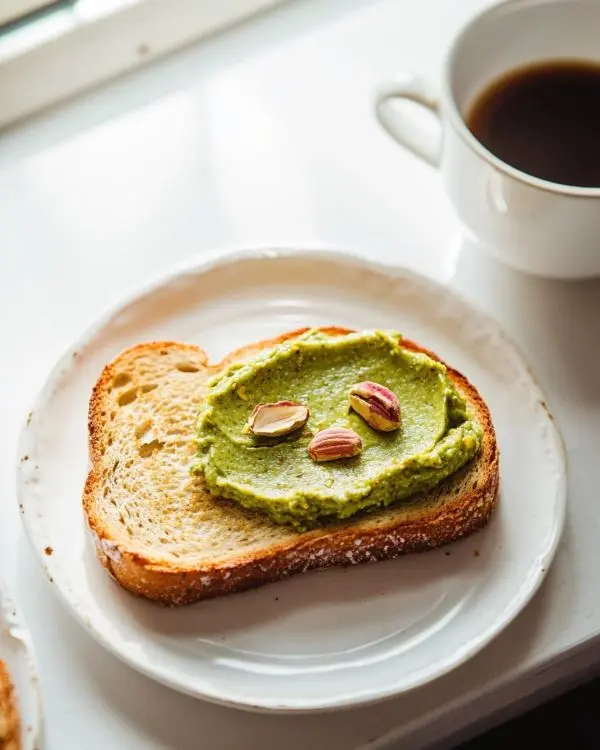
Spread it on toast for breakfast luxury. Swirl it into yogurt or oatmeal. Use it as a base for viral Dubai chocolate inspired desserts.
For baking enthusiasts, substitute pistachio butter in pistachio cupcakes for intensified flavor. It also works wonderfully in cookies, similar to how you’d use it in air fryer peanut butter cookies.
Is Pistachio Butter the Same as Pistachio Cream?
As pistachio cream, pistachio butter shares similarities but differs in key ways that affect taste and texture. Pistachio butter contains only ground pistachios and salt, creating a pure, dense spread. Pistachio cream often includes added sugars, oils, or dairy components, resulting in a lighter, sweeter product designed for dessert applications.
Understanding this distinction helps you choose the right product for your needs. When recipes call for “pistachio cream,” they typically want the sweeter, more processed version found in European pastries.
What’s the Difference Between Pistachio Butter and Pistachio Cream?
The difference Between pistachio butter and pistachio cream, the main distinctions lie in ingredients, consistency, and intended use. Pistachio butter focuses on pure nut flavor with minimal ingredients, while pistachio cream incorporates sweeteners and stabilizers for a smoother, dessert-like consistency.
Butter works better for savory applications like spreading on crackers or mixing into salad dressings. Cream suits sweet treats and pastries where you want that candy-like sweetness. Think of butter as the “natural” option and cream as the “dessert” version.
How Long Does Homemade Pistachio Butter Last?
Pistachio Butter last for up to one week at room temperature or one month refrigerated, homemade pistachio butter maintains peak quality when stored properly in airtight containers. Unlike commercial versions with preservatives, homemade varieties rely on natural oils for preservation.
Signs of spoilage include rancid smell, mold growth, or separation that doesn’t remix with stirring. Always use clean utensils when scooping to prevent contamination. For maximum freshness, store in glass mason jars rather than plastic containers.
FAQ about Pistachio Butter
What is pistachio butter good for?
For spreading on toast, baking delicious treats, and creating gourmet gifts, pistachio butter serves multiple purposes beyond simple snacking. Use it as a protein-rich base in smoothies, swirl it into yogurt, or incorporate it into cookie dough. Its rich, nutty flavor complements both sweet and savory applications beautifully.
Why is pistachio butter so expensive?
Pistachio butter is so expensive because of processing costs, premium packaging, and retail markup, commercial pistachio butter prices often shock consumers. When you make it yourself, you eliminate these expenses completely. Pistachios themselves cost more than other nuts due to their specific growing conditions and labor-intensive hand-harvesting methods.
What do pistachios do to skin?
To skin health, pistachios contribute vitamin E, antioxidants, and essential fatty acids that promote natural radiance. These compounds help protect against environmental damage while supporting collagen production. Regular consumption of pistachios may improve skin texture and reduce signs of aging.
Is pistachio butter healthier than peanut butter?
Than peanut butter, pistachio butter offers different nutritional advantages worth considering. Pistachios provide more antioxidants, vitamin B6, and potassium, while peanuts offer slightly more protein per serving. Both nuts deliver healthy fats and essential nutrients as part of a balanced diet.
Is it OK to eat nut butter every day?
Every day consumption of nut butter fits perfectly into balanced diets when portion sizes remain moderate. A serving size of 2 tablespoons provides healthy fats, protein, and essential nutrients without excessive calories. Listen to your body and adjust portions based on your activity level and dietary goals.
Why are pistachios so expensive?
pistachios so expensive because cultivation requires specific climate conditions, careful irrigation, and often hand-harvesting, these premium nuts command higher prices than other varieties. The labor-intensive growing process, combined with limited suitable growing regions, creates natural supply constraints that drive up costs.
Conclusion
Creating homemade pistachio butter transforms simple nuts into liquid gold. This recipe delivers restaurant-quality results in your own kitchen. The process requires patience, but the reward—creamy, rich, addictive pistachio butter—makes every minute worthwhile.
Pair your fresh pistachio butter with warm sourdough bread and a cup of coffee for the perfect afternoon treat. Better yet, gift jars to friends and family who’ll think you’re a culinary genius.
Remember that first batch I nearly burned? Now I make pistachio butter weekly, and it never lasts long in our house. Try this recipe, share your results on social media, and tag @DessertHaven—I love seeing your creations come to life!
What variations will you try first? The honey version or perhaps the savory rosemary blend? Either way, you’re about to discover why homemade always beats store-bought.

Pistachio Butter: Ultimate Homemade Recipe
Ingredients
Equipment
Method
- Preheat the oven to 350 degrees Fahrenheit. Spread the pistachios across a rimmed baking sheet and toast them until nicely fragrant, about 7 to 9 minutes, stirring halfway.
- Let the pistachios cool until they’re just warm (not hot), about 10 minutes.
- Transfer the pistachios to a food processor. Add a pinch of salt.
- Blend until the mixture is completely smooth and creamy, pausing to scrape down the sides as necessary. The pistachios will go from flour-like clumps, to a ball against the side of the food processor, and finally, the mixture will turn creamy and glossy. If the mixture gets hot along the way or your machine seems tired, stop and let it cool for a few minutes before proceeding.
- Taste, and blend in another pinch of salt if desired. Let the pistachio butter cool to room temperature, then transfer the mixture to a mason jar and screw on the lid. This nut butter keeps well at room temperature for 1 week or store it in the refrigerator for up to 1 month.

